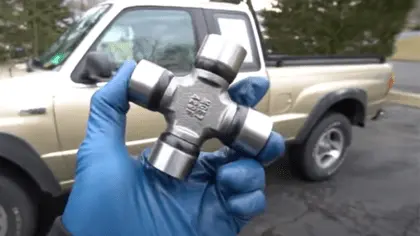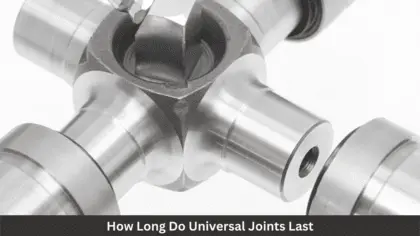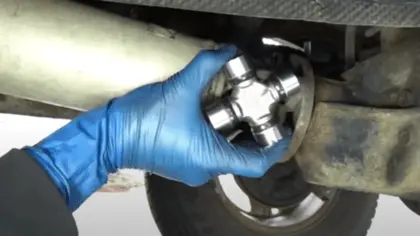It’s been a common question that is often asked, How long do universal joints last? But the answer isn’t always so clear. Universal joints (U-joints) have a finite lifespan and will ultimately require replacement, just like any other automobile component. However, there are a few factors that can affect how long your U-joints will last.
What are Universal Joints?

A universal joint, also known as a U-joint, is a mechanical coupling that allows two shafts to rotate at different angles. U-joints are commonly used in automotive applications, such as in the drive shafts of cars and trucks.
Universal joints are found in the drive shafts of both front and rear-wheel drive vehicles. They connect the drive shaft to the wheels and allow them to rotate at different speeds. As the name implies, universal joints are designed to move in a universal manner, meaning they can rotate in any direction.
U-joints are constantly moving and flexing as you drive, which can eventually lead to wear and tear. The amount of wear and tear will depend on a few factors, including the type of U-joint, the quality of the joint, and the driving conditions.
Types of Universal Joints
There are two main types of U-joints: ball and trunnion. Ball U-joints are the most common type of U-joint and can be found on most vehicles. Trunnion U-joints are typically found on heavy-duty vehicles, such as trucks and SUVs.
Both types of U-joints have their own advantages and disadvantages. Ball U-joints are less expensive and easier to replace, but they don’t last as long as trunnion U-joints. Trunnion U-joints are more expensive, but they’re designed to last longer and can handle more stress.
How Long Do Universal Joints Last?

There is no definitive answer to this question because there are a number of factors that can affect the lifespan of a universal joint. But on average, U-joints can last between 30,000 and 60,000 miles.
However, there are a number of factors that can cause a universal joint to fail prematurely.
Factors that affect the lifespan of a universal joint
The lifespan of a universal joint is affected by a number of factors, including the quality of the materials used, the design of the joint, the application in which it is used, and the maintenance and lubrication schedule. To know more detailed factors that can affect U-joints lifespan read these points below,
1. Lack of lubrication
Universal joints need to be properly lubricated to function properly. If they are not, the parts can wear out prematurely.
2. The quality of the joint
The quality of the joint is the most important factor in determining how long it will last. Universal joints are available in a variety of grades, from economy to high performance. The higher the quality of the joint, the longer it will last.
3. Contamination
If dirt or other debris gets into the universal joint, it can cause the parts to wear out prematurely.
4. The frequency of use
The frequency of use also affects the lifespan of a universal joint. Joints that are used more often will wear out more quickly than those that are used less often.
5. The type of loads applied to the joint
The type of loads applied to the joint also affects its lifespan. Joints that are subject to high loads, such as those in the drive shafts of trucks and off-road vehicles, will wear out more quickly than those that are subject to lower loads.
6. Misalignment
If the shafts that the universal joint connects are not properly aligned, it can cause the joint to fail prematurely.
7. Driving Conditions
The driving conditions will also affect how long your U-joints last. If you regularly drive on rough roads, your U-joints will wear out faster. If you only drive on smooth roads, your U-joints will last longer.
8. The environment in which the joint is used
The environment in which the joint is used also affects its lifespan. Joints that are used in corrosive environments, such as saltwater, will corrode more quickly than those that are used in non-corrosive environments.
If you think your universal joint may be failing, It’s crucial to have a skilled technician examine it as soon as possible. Universal joint failure can lead to serious problems, such as loss of control of the vehicle.
How to extend the lifespan of your universal joint
There are a few different things that you can do in order to extend the lifespan of your universal joint. One of the most important things is to make sure that you keep it properly lubricated. You should check the level of lubrication in your universal joint on a regular basis, and if it starts to get low, you should add more.
Another thing that you can do to extend the lifespan of your universal joint is to avoid putting too much stress on it. If you regularly tow heavy loads with your car, or if you take your car off-road a lot, then you may be putting too much stress on the universal joint. If you notice that your universal joint is making noise or seems to be working harder than usual, then you may want to have it checked out by a professional.
By following these simple tips, you can help to extend the lifespan of your universal joint and keep your car running properly for a long time to come.
Process of Replacing Universal Joints

If your car is making clicking noises when you turn, it may be time to replace your universal joints. Universal joints, or U-joints, are found on both front-wheel and rear-wheel drive cars. They allow the driveshaft to flex as the suspension moves up and down, and they eventually wear out. Replacing them is not a difficult task, but it is one that requires a little bit of patience.
The first thing you’ll need to do is jack up the car and support it on jack stands. Once the car is secure, you’ll need to remove the driveshaft. On rear-wheel drive cars, the driveshaft is connected to the differential with two U-joints. There is a U-joint at each end of the driveshaft.
To remove the driveshaft, you’ll need to disconnect the U-joints from the differential. There is a cap on each end of the U-joint that needs to be removed. Underneath the caps are the U-joint bearings. A holding ring fixes the bearings in position. Pull the bearings out of the differential after removing the retaining ring with a pair of pliers.
With the bearings removed, the U-joint caps can be pulled off of the driveshaft. The U-joints can now be removed from the differential.
To install the new U-joints, start by greasing the inside of the U-joint caps. Place the caps on the ends of the driveshaft and then insert the bearings into the differential. Use the pliers to put the retaining rings back in place.
Now, it’s time to reconnect the driveshaft to the differential. Start by slipping the end of the driveshaft into the differential. Once the driveshaft is in place, reconnect the U-joints. Put the U-joint caps on and then tighten them in place.
With the U-joints reconnected, the driveshaft can be reinstalled. Lower the car off of the jack stands and take it for a test drive.
Summary
Universal joints play an important role in your vehicle’s drive shaft. They connect the drive shaft to the wheels and allow them to rotate at different speeds. U-joints are constantly moving and flexing as you drive, which can eventually lead to wear and tear. The amount of wear and tear will depend on a few factors, including the type of U-joint, the quality of the joint, and the driving conditions. In general, U-joints will last between 30,000 and 60,000 miles. If your U-joints start to wear out, it’s important to replace them as soon as possible.

